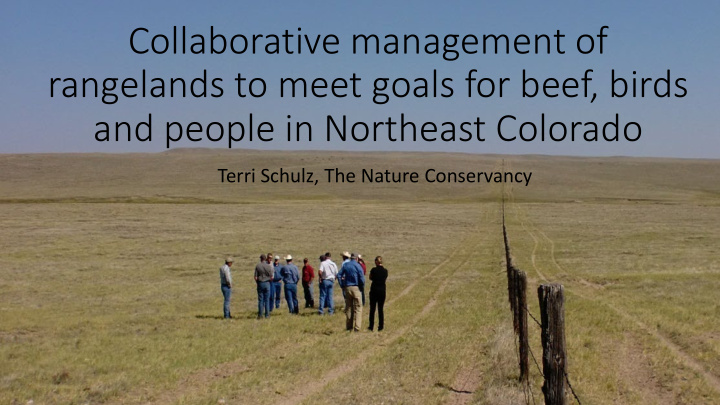



Collaborative management of rangelands to meet goals for beef, birds and people in Northeast Colorado Terri Schulz, The Nature Conservancy
Collaborative Adaptive Rangeland Management (CARM) Purpose to examine how science can be conducted in a real-world manner (i.e., at ranch-level scales with manager involvement) to evaluate the effectiveness of adaptive grazing management for both production and conservation goals.
Research Team Decision-maker Group
Goal: Manage the land in order to pass it on to future generations -Economically -Ecologically Collaborative Profitable ranching Wildlife Vegetation Learning operations
Vegetation A) Attain and/or maintain abundances of cool-season perennial graminoids within 30% of targets for each plot. B) Maintain or increase plant compositional diversity both within and across pastures. C) Increase variation in vegetation structure, composition, and density within and among pastures. D) In pastures that had stands of four-wing saltbush at the start of experiment, increase or maintain cover relative to baseline.
Profitable ranching operations A.Maintain or increase livestock weight gain B.Reduce economic impact of drought C.Maintain or reduce operating costs
Wildlife A. Increase populations of mountain plover. B. Maintain populations of McCown’s longspur, Western meadowlark, and horned lark C. Increase populations of grasshopper sparrow, Cassin’s sparrow, Brewers sparrow, and lark bunting D. Maintain control of prairie dog populations (No prairie dogs.)
Collaborative Learning A. Apply new knowledge and CARM in new areas B. Respect, understanding and trust increases among stakeholders and researchers C. Stakeholders and researchers co-produce new knowledge
Spatial Prioritization Tony Morris
Pre-Drought Drought Post-Drought Year Year Year Treatment (Early) Grass Banking Promote cool- season perennials Early post-drought (managing for Grass Bank forage production heterogeneity) maintains stocking Grasshopper enhanced by rate Sparrow grassbanking or McCown’s not impacted Longspur No Grass Banking (managing for the middle) Horned Lark Reduce Stocking Rate (-$)
Summary • Collaboration moves at the speed of trust • All goals need to be “owned” by all decision-makers • Having explicit learning goals is invaluable
Learn More: Wilmer, Hailey, Justin D Derner, Maria E. Fernández-Giménez, David D Briske, David J Augustine, Lauren M Porensky, and The CARM Stakeholder Group. 2018. “Collaborative Adaptive Rangeland Management Fosters Management-Science Partnerships.” Rangeland Ecology & Management 71 (5): 646–57. Digital Fact sheet: https://spark.adobe.com/page/cDD9u5v5ZeC88/
Recommend
More recommend